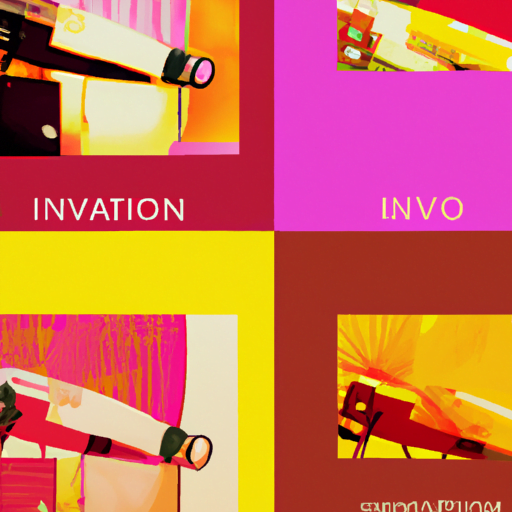
-
Table of Contents
- Innovations in App Interface Design
- The Importance of App Interface Design
- Latest Innovations in App Interface Design
- 1. Minimalistic Design
- 2. Microinteractions
- 3. Voice User Interface (VUI)
- 4. Dark Mode
- Case Studies: Successful Implementation of Innovative App Interface Design
- 1. Instagram
- 2. TikTok
- Key Takeaways
Innovations in App Interface Design

With the rapid advancement of technology and the increasing popularity of smartphones, app interface design has become a crucial aspect of creating successful mobile applications. A well-designed app interface not only enhances user experience but also plays a significant role in attracting and retaining users. In this article, we will explore some of the latest innovations in app interface design and how they are revolutionizing the way we interact with mobile applications.
The Importance of App Interface Design
Before diving into the innovations, it is essential to understand why app interface design is so important. The interface is the bridge between the user and the app, and a poorly designed interface can lead to frustration and abandonment. On the other hand, a well-designed interface can make the user feel comfortable, engaged, and more likely to continue using the app.
Here are some key reasons why app interface design matters:
- User Engagement: A visually appealing and intuitive interface encourages users to explore the app and engage with its features.
- Usability: A well-designed interface makes it easy for users to navigate through the app and accomplish their tasks efficiently.
- Brand Image: The interface design reflects the brand’s identity and values, helping to create a positive impression on users.
- Competitive Advantage: In a crowded app market, a well-designed interface can differentiate an app from its competitors and attract more users.
Latest Innovations in App Interface Design
Now that we understand the importance of app interface design, let’s explore some of the latest innovations that are shaping the industry:
1. Minimalistic Design
Minimalistic design has gained significant popularity in recent years. This design approach focuses on simplicity, removing unnecessary elements and clutter from the interface. By using clean lines, ample white space, and a limited color palette, minimalistic design creates a visually appealing and uncluttered interface.
One of the key advantages of minimalistic design is its ability to improve usability. With fewer distractions, users can focus on the essential elements of the app and navigate through it more easily. Additionally, minimalistic design often results in faster loading times, enhancing the overall user experience.
Example: The Dropbox app is an excellent example of minimalistic design. It features a clean and simple interface with a limited color scheme, making it easy for users to navigate and access their files.
2. Microinteractions
Microinteractions are small, subtle animations or visual cues that provide feedback to users when they interact with an app. These interactions can be as simple as a button changing color when pressed or more complex, such as a loading animation.
Microinteractions serve multiple purposes in app interface design. They provide immediate feedback to users, making them feel more in control and engaged with the app. Additionally, microinteractions can guide users through complex processes, such as form submissions or file uploads, by providing visual cues and progress indicators.
Example: The Facebook “Like” button is a classic example of a microinteraction. When a user clicks the button, it instantly changes from gray to blue, providing immediate feedback and reinforcing the action.
3. Voice User Interface (VUI)
Voice User Interface (VUI) is a rapidly growing trend in app interface design. With the rise of virtual assistants like Siri, Alexa, and Google Assistant, users are becoming more comfortable interacting with apps using their voice.
VUI allows users to perform tasks and navigate through an app by speaking commands instead of using traditional touch or click interactions. This innovation opens up new possibilities for hands-free and eyes-free app usage, particularly in situations where users cannot physically interact with their devices.
Example: The Amazon Alexa app utilizes VUI to enable users to control their smart home devices, play music, and access various services using voice commands.
4. Dark Mode
Dark mode, also known as night mode, has gained popularity in recent years due to its aesthetic appeal and potential benefits for user experience. Dark mode replaces the traditional light background with a dark background and light text and elements.
One of the primary advantages of dark mode is its potential to reduce eye strain, particularly in low-light environments. Dark backgrounds also help to highlight content and make it stand out, creating a visually pleasing experience.
Example: The Twitter app offers a dark mode option, allowing users to switch to a dark background for a more comfortable reading experience in low-light conditions.
Case Studies: Successful Implementation of Innovative App Interface Design
Let’s take a look at two case studies that demonstrate the successful implementation of innovative app interface design:
1. Instagram
Instagram, a popular social media platform, has continuously evolved its app interface design to enhance user experience and engagement. One of the notable innovations introduced by Instagram is the Stories feature.
The Stories feature allows users to share photos and videos that disappear after 24 hours. The interface design for Stories includes intuitive gestures, such as swiping left or right to navigate between stories, and tapping to interact with stickers and other elements.
This innovative interface design has significantly contributed to the success of Instagram, with millions of users engaging with Stories on a daily basis.
2. TikTok
TikTok, a short-form video app, has taken the world by storm with its innovative app interface design. The app’s interface is centered around a personalized feed of short videos, with a seamless scrolling experience.
TikTok’s interface design focuses on simplicity and discoverability. Users can easily swipe up or down to switch between videos, and the app’s algorithm suggests relevant content based on their preferences and interactions.
This unique interface design has played a significant role in TikTok’s rapid growth and popularity, attracting millions of users worldwide.
Key Takeaways
App interface design is a critical factor in creating successful mobile applications. By incorporating the latest innovations in app interface design, developers can enhance user experience, improve usability, and differentiate their apps from competitors.
Here are the key takeaways from this article:
- App interface design plays a crucial role in user engagement, usability, brand image, and competitive advantage.
- Minimalistic design focuses on simplicity and enhances usability.
- Microinteractions provide feedback and guide users through app interactions.
- Voice User Interface (VUI) enables hands-free and eyes-free app usage.
- Dark mode reduces eye strain and highlights content.
- Successful case studies, such as Instagram and TikTok, demonstrate the impact of innovative app interface design on user engagement and app popularity.</
